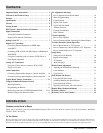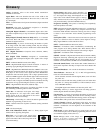
Analog—Commonly refers to the current NTSC transmission
standard for televisions.
Aspect Ratio—This term describes the ratio of the width to the
height of a TV screen independent of the screen size (x units wide
by x units high).
ATSC—Advanced Television Systems Committee (digital standards
committee).
Bandwidth—The range of frequencies assigned to a broadcast
channel. A TV channel is 6 MHz wide.
ClearQAM Digital Channels—Unscrambled digital cable chan-
nels. Cable companies may or may not choose to provide ClearQAM
channels.
Dolby® Digital (Formally known as Dolby AC-3)—A 5.1 channel
(Front L/R, Rear L/R, Center, and Bass) surround sound audio
standard for digital television.
Downconverting—A process for decreasing the number of pixels
in an image. Frame rate and/or scanning format may also change.
Broadcasters may use this process to make room in their bandwidth
for additional services.
DTV (Digital Television)—Comprises three elements, HDTV,
EDTV, and SDTV.
DVI (Digital Video Interface)—Designed to accommodate
both analog and uncompressed digital video signals with a single
connector.
EDTV—Enhanced Definition Television (480p).
HDCP—High-bandwidth Digital Content Protection. A means of
protecting copyrighted digital entertainment content.
HDMI—High Definition Multimedia Interface. HDMI is a new stan-
dard digital connection between A/V devices, such as a set-top box,
DVD player or A/V receiver, and a digital television. HDMI offers
exceptional video and audio quality with a single quick-disconnect
connector. HDMI supports multi-channel digital audio transmissions
and component video color spacing for true rendering of high-
definition video. It supports the HDCP protection standard, allowing
transmission of copy-protected digital content to your display.
HDTV—High Definition Television (1080i & 720p).
Interlaced Scanning—The process of scanning two fields of video
then combining (interlacing) them to make one frame.
Letter Box—A widescreen 16:9 aspect ratio image
being displayed on a 4:3 aspect ratio screen. Black
borders appear at the top and bottom of the screen
(image fails to fill screen vertically).
Multicasting—The dividing of a station’s broadcast signal into sub-
channels of programming or data services.
NTSC—National Television Systems Committee (analog standards
committee).
OSD—On Screen Display.
Pulse Code Modulation (PCM)—This is a binary digital signal
format used for digitizing analog data.
Pillar Box—A 4:3 aspect ratio image being
displayed on a 16:9 ratio screen. Black borders
appear at the sides of the screen (image fails to fill
screen horizontally).
Postage Stamp—This term is used to describe a 4:3
aspect ratio image that the broadcaster has up-coverted
to a 16:9 aspect ratio image, then displayed on a 4:3
aspect ratio screen. Black borders appear at the top,
sides, and bottom of the screen (image fails to fill screen both verti-
cally and horizontally). (See Zoom definition below.)
Progressive Scanning—The process of scanning lines sequentially.
One field produces one frame.
PSIP—Program and System Information Protocol is a collection of
tables designed to operate within every transport stream for DTV
broadcasts. PSIP includes instructions advising TVs that a change
is about to occur and where virtual channel programming can be
found.
Set-Top Box (STB)—A device that receives and converts signals for
display on a television screen or monitor (can be digital or analog).
Many digital STBs have cable and off-air tuners.
SDTV—Standard Definition Television (480i).
Simulcast—A broadcast station simultaneously broadcasting the
same program on an analog channel and a DTV channel. This is
required by the FCC during the transition from analog to digital.
Spectrum—A continuous band of frequencies.
S/P DIF —S/P DIF is a digital audio format that can transmit a Dolby
Digital bit stream. By connecting this output to an AV receiver that
includes a Dolby Digital decoder, the TV can reproduce up to 5.1
channels of surround sound. S/P DIF can also transmit PCM audio.
Surround Sound (Front)—This feature adds another dimension to
the acoustic experience and helps to improve the movie-theater like
sound.
Terrestrial Broadcast—An over-the-air broadcast to an antenna.
Tuner Indicator—The letters “D,” “C,” or “DC” will appear directly
to the left of the channel number:
Off-air channels selected with the digital (DTV) tuner will have
the prefix “D.”
Channels selected with the analog (NTSC) tuner will either have
the prefix “C” (analog cable channels) or will be blank (for terres-
trial, VHF/UHF channels).
ClearQAM digital cable channels will have the prefix “DC.”
Tuner Key—This key is used to toggle from one tuning system to
another, digital channels and analog channels.
Upconverting
—A process for increasing the number of pixels in an
image (may include changing the frame rate and scanning format).
Additional pixels are inserted between existing pixels in an attempt to
simulate HDTV. This process does not increase the resolution.
Virtual Channel—Channels broadcasted with major and minor
information contained in the PSIP package. The number of virtual
channels a broadcaster can send depends on the resolution of the
programming.
Wide-Screen—Used to describe a 16:9 or greater aspect ratio. 16:9
is the standard aspect ratio for HDTV programming. Movies screens
are sometimes slightly wider (often 2:1).
Zoom—Enlarges center of the image. For
instance, if you have a postage stamp image
shape, press this key to enlarge image.
Glossary
Glossary 5


















